I THOUGHT I knew Brittany from family holidays way back. A sea-washed, misty Celtic land of rockpools and granite cliffs, megaliths and obscure saints – a kind of even more overcrowded Cornwall with crepes.
Beautiful Brittany, Celtic and mysterious, has always felt kind of strange to me. It just got stranger.
Exploring further on a recent off-season trip, the cliches rolled away and it yielded all kinds of quirky treasures, not least inland among its forested hills and in the reinvented industrial port of Nantes. A gigantic mechanical elephant and a phantasmagoric, fish-driven carousel with not a stripy jumper and beret in sight.
That bustling city still feels and behaves like the Breton capital it traditionally was until shunted into the Pays de Loire in 1962. The great river has always been its mercantile lifeblood, but there’s also a more sedate waterway that bears its name, the Nantes-Brest Canal, a 385km long 19th century commercial ‘shortcut’ today given over to leisure. We never took to its weaving waters but crossed its path several times on our Brittany road-trip. Eventually we stayed B&B on its banks in a setting eerily reminiscent of our ramshackle Pennine homeland.
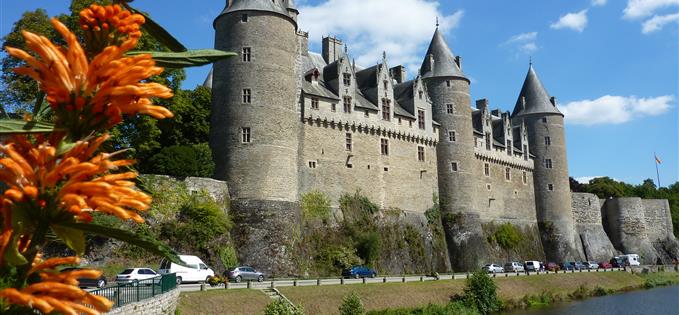
This whole central area of Brittany has for centuries been the fiefdom of the Lords of Rohan. The only remaining branch still owns the Castle of Josselin, a stupendous bastion on a cliff overlooking the Canal. It’s open to the public (guided tours, in English only in summer) and the chatelaine also presides over a 5.000-strong doll and toy museum, but we were more intrigued by the hilltop town’s Basilica, gargoyles, ‘miraculous fountain’ and all.
Notre Dame de Ronciers translates as Our Lady of the Bramble Bush and she is the object of the annual ‘Le Pardon’ pilgrimage there every September. Her story? A ninth century ploughman working beside the River Oust (which now doubles up as the Canal) found a crowned statue of the Virgin in a bramble bush. The salvaged statue returned to the bush and gave his blind daughter sight, so he built a chapel on the site, which became Josselin. The statue in the procession is a replacement for the original, destroyed by revolutionaries.

Climb the 135 steps to the top of the steeple for the best view of castle and countryside, then admire the imposing tomb of castle builder and later Constable of France Olivier de Clisson and his wife (below).

Afterwards the town itself is a delight to wander round with more than 50 half-timbered, flower-decked houses lining its streets.
 Rochefort oozes the quirky charm that has won it so many admirers
Rochefort oozes the quirky charm that has won it so many admirers


On a much smaller scale, 40km south, is picture perfect Rochefort en Terre, voted in a 2016 telly poll “French folk’s favourite village”. We liked the jumble of different architectural periods rand the chichi craft ateliers rubbing shoulders with artisan gingerbread bakers Le Rucher Fleuri. An abundance of cobbles and windowboxes added to the charm.
Rochefort was put on the map in the early 20th century after a wealthy French-born American painter called Alfred Klotz bought the local château. Dating back to the 12th century, the château was destroyed by Republicans in 1793 and only the façade remains; the current mansion (below) was constructed by Klotz.

His artistic baton has been taken up in the grounds by the Naia Museum, named appropriately after an early 20th century witch who lived in the town. It celebrates mavericks creating the kind of fantasy and kinetic art and sculpture scorned by the establishment. Don’t miss the dungeon installation!
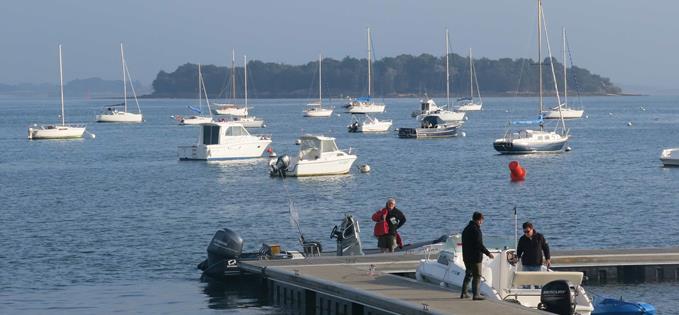
Rochefort falls within the Morbihan department, named after the “small sea” that is the dominant feature of the Southern Breton coastline. The island-studded Golfe de Morbihan is not quite enclosed; tides sweep through a gap between the peninsulas of Rhuys and Locmariaquer. They share a glorious climate that can accommodate figs, pomegranates, even Brittany’s only vineyards.
 Logeo is a tranquil haven in the Morbihan
Logeo is a tranquil haven in the MorbihanThe beaches once you find them down long, winding lanes are exquisite. Le Logeo, small boats anchored in its cove, is mega pretty but larger Arzon or Port Navalo is where you’ll eat fish lunch with a view. And out in the marshes seek out the fairytale moated castle of Suscinio.
 Colourful beach huts on the Ile-aux-Moines
Colourful beach huts on the Ile-aux-MoinesOut in the Gulf lie more than 40 islands, many privately owned. For seekers after ancient traces travel out to Gavrinis with its wealth of menhirs and stone circles; we took the five minute Izenah Croisieres ferry ride to the largest island, the Île-aux-Moines, which has a Greek island feel to it with white fishermen’s houses and winding alleys. It’s so easy to follow one of the coastal tracks and have the place to yourself (well, in October we could).
 Scallop galettes; wash them down with some local cider
Scallop galettes; wash them down with some local cider 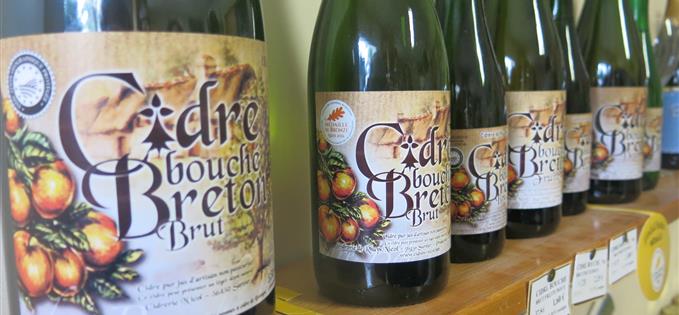
It takes four hours to do the 17km round trip of the island via the footpath. That’s if you’re not tempted to stop en route for a glass of Muscadet and half a dozen oysters. Alas, we’d dined handsomely earlier on galettes, Brittany’s buckwheat pancake speciality, and tasted Royal Guiilevec cider in the orchards of award-winning Cidre Nicol.
 Vannes Market with its abundance of seafood (below)
Vannes Market with its abundance of seafood (below) 
This is wonderful foodie territory. Witness Vannes’ Saturday market, one of France’s finest. As a regional centre it attracts the finest produce, stunning fish especially, and what a setting, the town’s gloriously unspoilt medieval heart. The stalls stretch from the Halles in the Place des Lices into the half-timbered streets that rise up to the sombre Cathedral of St Pierre, a hotchpotch of many architectural styles.
 Thierry Seychelles; below, his Michelin-starred restaurant is in the heart of the old town
Thierry Seychelles; below, his Michelin-starred restaurant is in the heart of the old town 
Chef Thierry Seychelles (above) is up early to select the pick of the catch. Only hours earlier we had dined sumptuously at his Michelin-starred restaurant, Le Roscanvec. This isn’t one of those intimidating gourmet palaces. It’s artfully homely, the young staff relaxed but on the ball. And the food? Simple and sublime.

To start langoustines and scallops in a miso emulsion with sichuan pepper (above), for mains slow-cooked monkfish with ceps, meat juices and sherry vinegar, followed by red fruits with hibiscus sorbet, pistache cremeux and, a playful touch, candyfloss.
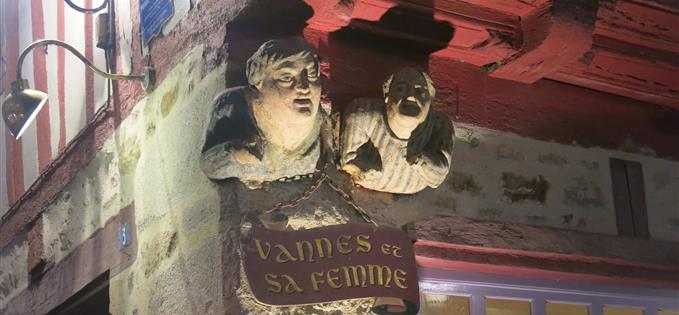 Vannes after dark; below, its cobbles streets offer a wealth of half-timbered properties
Vannes after dark; below, its cobbles streets offer a wealth of half-timbered properties

After dinner it was a treat to wander the dimly lit, cobbled streets to grab a nightcap in the Place Marechal Joffre with its view of shadowy boats bobbing across the waterways. Then we took the ancient bridge over the town moat with its 16th century washhouses back to our lodgings.
All this is in such contrast to bustling Nantes. If driving around Vannes’ ring road system was challenging, it was nothing compared with the big city’s gridlock.
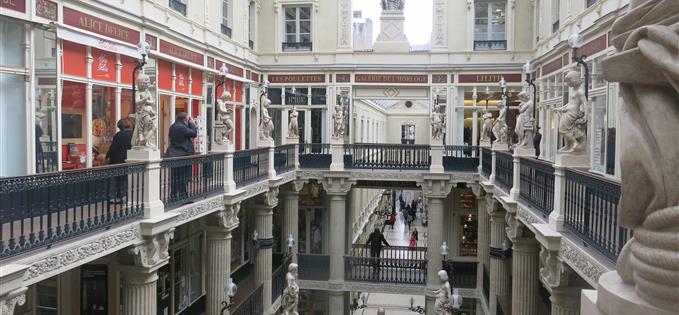 Passage de Pomeraye is an eyecatching shopping spot; below, the nearby Theatre de Graslin (Opera House)
Passage de Pomeraye is an eyecatching shopping spot; below, the nearby Theatre de Graslin (Opera House) 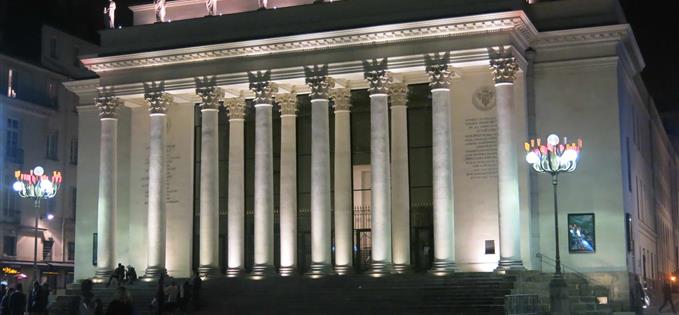
Fortunately the rather grand centre is pedestrianised. Get a feel for the place by strolling down from the Place Graslin with its classical Opera House to the Place Royale, detouring via the Passage Pommeraye, a unique ‘shopping mall’ from the 1840s, its elaborate stairs aiding your steep descent like (if it’s not too fanciful) a set of canal locks. With its Renaissance-style statues and marble cherubs grasping gas lamps it feels like a stage set and has featured in Jacques Demy films including Les Parapluies de Cherbourg.
 La Cigale, a popular period brasserie that specialises in seafood (and superb service)
La Cigale, a popular period brasserie that specialises in seafood (and superb service)Even more over the top is La Cigale in the Place Graslin, an opulent 19th century brasserie that has made few concessions to the passage of time. Essential accompaniment to your fish platter a bottle of Muscadet sur lie from the appellation’s vineyards south of the river.
There’s much to savour in the city itself. On a guided tour we discovered how the 18th century slave traded funded magnificent merchants’ houses, some of which still line the quayside, explored the moated Ducal Castle and admired the vast limestone Gothic Cathedal of St Peter and St Paul, which took 400 years to complete.
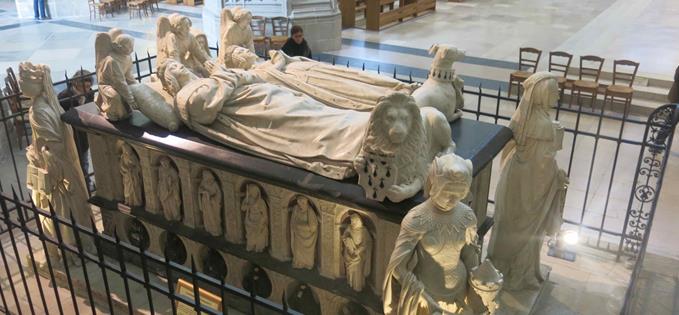 Nantes monument
Nantes monumentDon’t miss the elaborate tomb of Francis, Duke of Brittany, and his wife Marguerite, surrounded by angels and The Virtues, Strength, Prudence and Fidelity. The tomb niches contain ‘weepers’ and small figures of the saints with 16 mourners drawn from the common people. Remarkable.
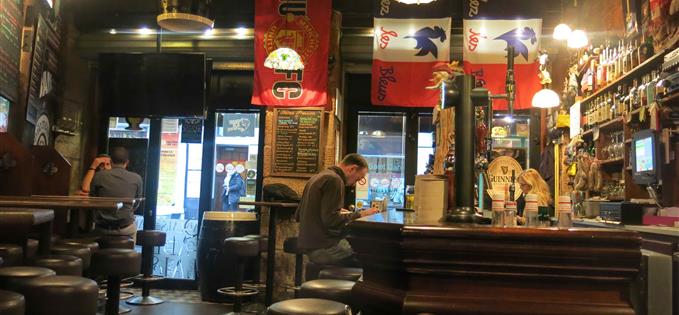 Le Rabelais, perfect place for a refreshing pit-stop
Le Rabelais, perfect place for a refreshing pit-stopAfter all this exploration we were glad to discover laidback Le Rabelais on the Rue du Bouffay, superficially an Irish pub but stocking a range of global craft beer at reasonable prices.
 Home of the rigolette and , below, sweet tooth-centric Georges Gautier
Home of the rigolette and , below, sweet tooth-centric Georges Gautier

More our thing than Nantes’s celebrated ‘rigolette', a cooked sugar shell encasing a choice of fruit jams. It was created in the early 20th century by a Monsieur Bohu, who named it after his cat. The original shop with its blue and gold mosaic frontage is still there in the Rue de Verdun. Equally perfectly preserved (and working too) is the Georges Gautier confectionery/chocolatier shop on the Rue de la Fosse, which is like entering heaven and discovering it smells of chocolate.

Such evocations of the past are delightful, but Nantes has been busy reinventing itself for the post-Industrial age in the very heart of its former shipyards on the ‘island’ where the Loire splits. Cross the bridge and enter the realm of the Giant Mechanical Elephant, epicentre of an artistic/touristic cross-fertilisation – on a brownfield site that is now attracting a host of newbuildings including the spectacular riverside Law Courts.
I like the spiel that accompanies "Les Machines de l’île": “At the crossroads of the imaginary worlds of Jules Verne. From the mechanical universe of Leonardo da Vinci to the industrial history of Nantes, these monumental structures are urban sculptures open to the general public.”
Created by two ‘mad’ artists a decade ago, a bit Cirques du Soleil, a bit hi-tech Heath Robinson, it is still a work in progress. You can see that in the workshops on site, where new creations are taking form. And it is definitely fun.


We loved riding on the Carousel Mondes des Marins, a kind of theatre in the round cum sculpture come tiered cake, where all the rides are spooky sea creatures – a homage to one of Nantes’ greatest sons, Jules ’20,000 Leagues Under The Sea’ Verne. Born here in 1828 he wasn’t particularly keen on his home town (still it has a museum in his honour).
We’re sure, though, he would have adored the Galerie des Machines with its mechanical heron, giant ant and new for this year, a spider. Star of the show is definitely the awe-inspiring Grand Elephant, 40ft high, 26ft wide, 70ft long and nearly 50 metric tons of steel and wood; it’s operated by a 450hp motor enabling it to travel at up to 3km per hour for 30 minutes at a time with 50 passengers perched on its terrace or in its lounge. Kids will love it.
Beautiful Brittany, Celtic and mysterious, has always felt kind of strange to me. It just got stranger.
Factfile
Neil stayed at the Hôtel de France Oceania (below) 4 Rue Crébillon, 44000 Nantes. +33 2 40 73 57 91. An 18th century townhouse recently refurbished and in the heart of the city.
 Nantes hotel
Nantes hotelMaison de la Garenne B&B, 2 Rue Sébastien de Rosmadec, 56000 Vannes. +33 2 97 67 00 31. A stylish period house dating back to 1898, set in a garden of camellias and hydrangeas alongside the medieval town walls and just a minute from the old town..
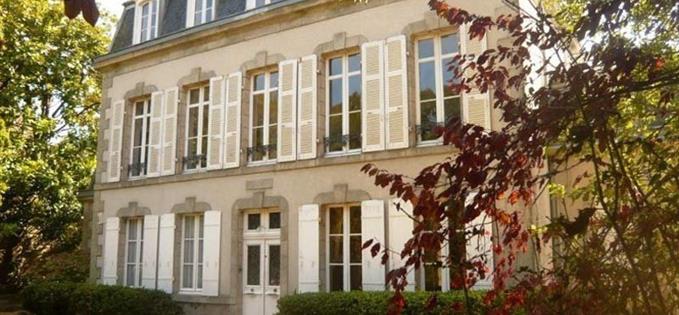
La Villa Tranquilité, 6 Rue de la Minoterie, 56580 Rohan +33 2 97 38 58 68. A hippyish canalside haven, laidback and full of character.
 Canalside lodging
Canalside lodgingNeil flew from Manchester to Nantes with www.flybe.com who run a regular service four times a week. He parked at Manchester Airport. For full details of parking options there visit this link.
For a full tourist guide to Brittany visit www.brittanytourism.com. For Nantes. Buy yourself a Nantes Pass to get around and into its attractions. a 72 hour one costs 45€.
Machines of the Isle of Nantes, Parc des Chantiers, Boulevard Léon Bureau, 44200 Nantes.
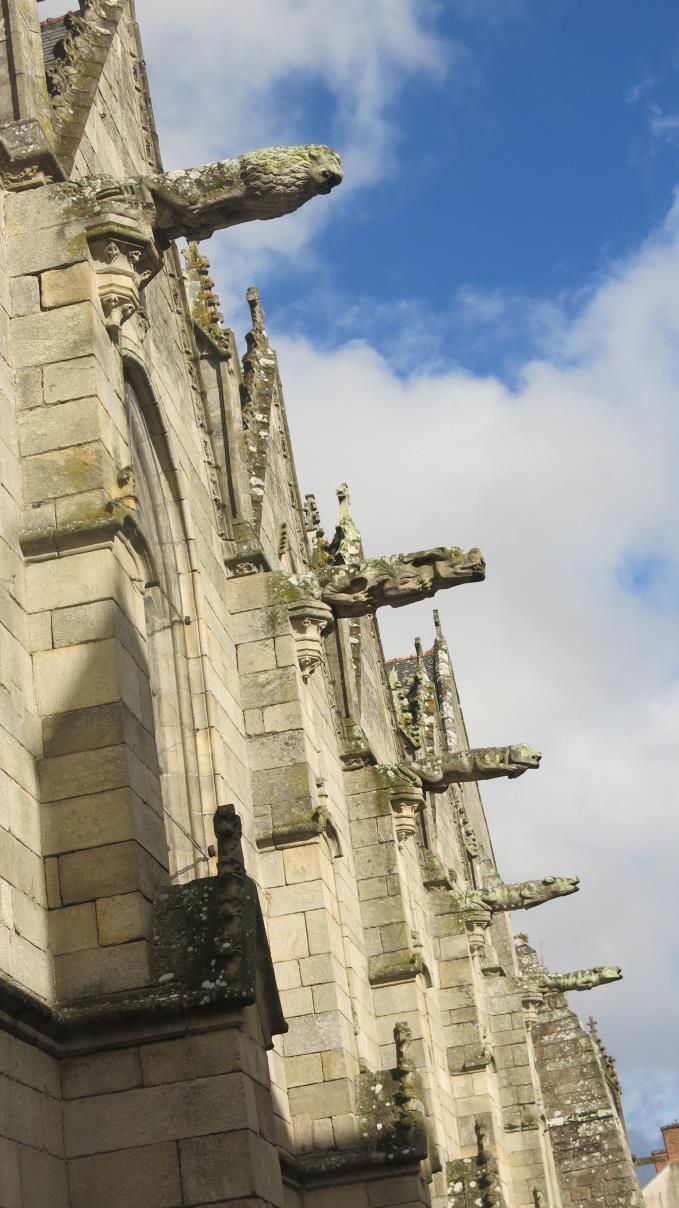 Gargoyles guard Josselin's Notre Dame des Rosiers and Our Lady, below
Gargoyles guard Josselin's Notre Dame des Rosiers and Our Lady, below

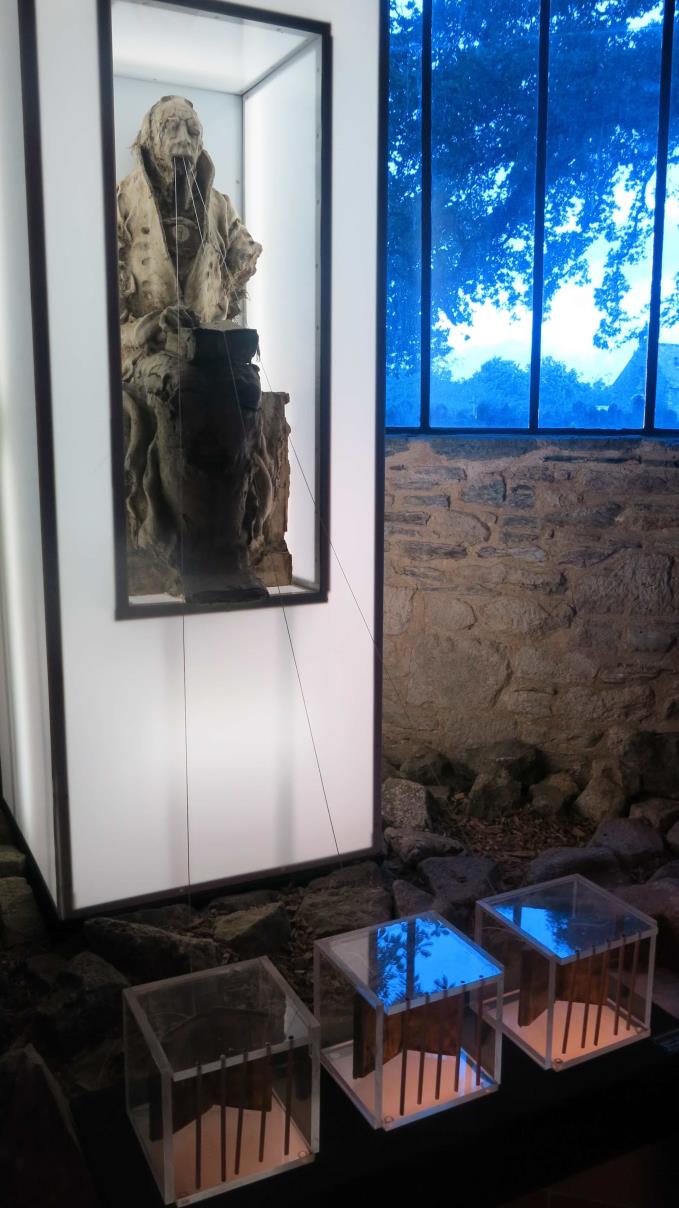 Fantasy figure in Rochefort's intriguing Naia Museum
Fantasy figure in Rochefort's intriguing Naia Museum
 Vannes Cathedral by night
Vannes Cathedral by night Powered by Wakelet
Powered by Wakelet










